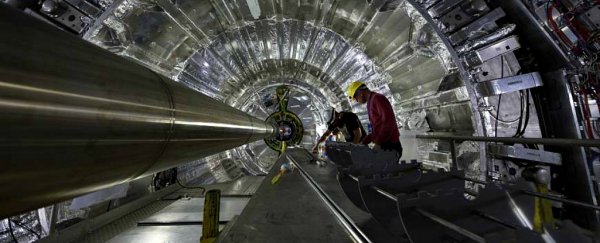The Large Hadron Collider (LHC) is already the most powerful particle accelerator out there, but it's about to get even more impressive.
Officials at the European Organisation for Nuclear Research (CERN) just upgraded a crucial part of one of the LHC's four experiments, and you can watch engineers open up the giant 'atom smasher' and tinker with its insides below.
The upgrade, which has been compared to a heart transplant, was made to the Compact Muon Solenoid (CMS) experiment, which was key to confirming the existence of the Higgs boson particle back in 2012.
Thanks to the change, the CMS now has a new pixel detector - a camera right at the heart of the detector that's used to track particles as they fly through experiment at close to the speed of light - and it should be even more sensitive to new physics than before.
You can watch the Facebook live discussion on the upgrade below:
The LHC is a 27-km-long (17-mile) tunnel that lies beneath the Swiss-French border. Its job is to accelerate beams of particles travelling in opposite directions to near the speed of light and smash them into each other, so that scientists can peer into the resulting debris for signs of new physics and elusive subatomic particles.
But many people don't realise that the LHC isn't just one experiment - it's made up of different detectors that record the outcomes of these particle collisions, and one of the largest is the CMS experiment.
The CMS experiment is as tall as a four-storey apartment building, and as long as a pair of school buses.
The pixel tracker camera at the heart of the experiment is designed to reconstruct the paths of particles and subatomic particles that emerge from the atom collisions, and the new one is capable of recording around 120 million pixels at 40 million frames per second - almost twice as precise as the previous model.
"It's like substituting a 66 megapixel camera with a 124 megapixel camera," Austin Ball, technical co-ordinator for the CMS experiment, told Paul Rincon from BBC News.
You can see more footage of the transplant happening below, and it provides some pretty gorgeous and unique views of the experiment:
"The heart of the CMS experiment is the pixel detector, the innermost instrument in the very heart of the CMS apparatus, the very point where new particles, such as the Higgs boson, are produced by the energy of the proton proton collisions of the LHC accelerator," CERN explained in a press release.
The hope is that with this new US$17 million part, the CMS experiment will be capable of detecting particles that are now lost to us, and could help LHC staff solve some outstanding mysteries, such as supersymmetry or dark matter.
The operation started around Christmas, when the LHC is turned off each year during winter. The first half of the detector was installed on Tuesday, February 28, with the final touches made on Thursday, March 2.
The CMS will now undergo several rounds of testing before the LHC is switched on again on May 1.
"Now the big work starts," Ball told Ryan F. Mandelbaum from Gizmodo. "Connecting this thing up, commissioning it and making sure we can do physics with it."
The upgrade comes after the LHC hit new record-high energies back in 2015, and fits into the goal of making sure the machine is capable of keeping up with the questions physicists are asking.
"We have to make sure that our detectors can keep up with what's being thrown at them… we're trying to access rarer processes, and to do that you need to produce and record more collisions between protons," Ball told Rincon.
"Very often, only slight deviations from theoretical predictions are the clues to new things we should be looking for."
No word yet on whether the CMS might now be powerful enough to spot the potential presence of ghosts.
